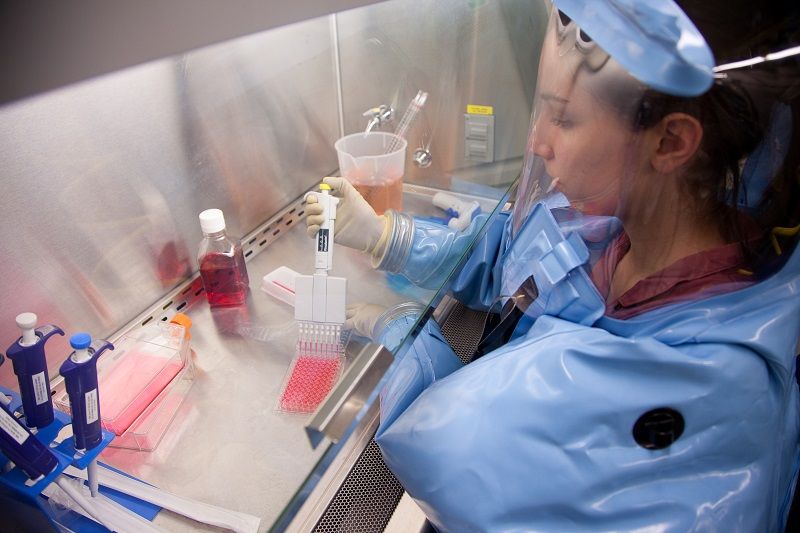Ebola Drug 'ZMapp' Saves Infected Monkeys, Study Shows

An experimental drug called ZMapp, which contains a cocktail of three antibodies that fight the Ebola virus, has successfully treated 18 monkeys infected with the deadly disease, researchers reported today. The new results raise hope that the drug may also work in people who are infected in the current Ebola outbreak in West Africa, the researchers say.
On the basis of these results in monkeys, several human patients had recently received the latest drug, before the details of the study were published today (Aug. 29) in the journal Nature.
"The success was great," co-author Gary Kobinger, chief of special pathogens at the Public Health Agency of Canada, told reporters at a news conference about the study. "It's an important step forward in the fight against Ebola virus."
In their study, the researchers administered the drug every three days to monkeys infected with Ebola. Some monkeys received the treatment starting on either day three or four after they were infected with the virus, and some even started the treatment on day five, when the animals were only days from reaching the end. [Ebola Virus: 5 Things You Should Know]
All 18 monkeys in the study recovered from the infection, without showing any lingering effects of the disease, the researchers said.
The drug contains three antibodies, which are molecules that can bind to a foreign protein. Several studies on mice and guinea pigs involving various combinations of six antibodies preceded the new findings, and helped the researchers zero in on the best combination of three antibodies to test on monkeys.
The treatment reversed severe symptoms of the Ebola disease, such as bleeding, rashes and elevated liver enzymes. Three monkeys in the study that did not receive the drug, and served as a control group, died eight days after infection, according to the study.
Sign up for the Live Science daily newsletter now
Get the world’s most fascinating discoveries delivered straight to your inbox.
With the new results, steps may be taken to use the drug in more people, the researchers said. If the drug is further shown to be safe in people, its use could be accelerated under laws allowing for the "compassionate use" of a drug that has not been proven, but may help people who have a disease that has no cure.
However, production of the drug takes time and needs large-scale facilities. The company that has been making limited doses of ZMapp for research doesn't have the capacity to make large quantities of the drug, the researchers said.
Some doses of ZMapp were recently diverted from research purposes to be used in treating four Ebola patients, including two American health care workers who recovered. But it is not possible to know whether the drug had any role in their recovery, experts say. In the current outbreak, about 47 percent of patients have survived.
The drug was also given to a Spanish priest and a Liberian doctor, but they didn't survive. Still, this doesn't mean the drug is not effective, because these two patients appear to have received only one dose, and perhaps too late.
"There is a limit. We know at one point there's a point of no return, where there's too much damage in the major organs to go back, and that's just the reality of it," Kobinger said. There are also other factors that come into play, he added, for example, the age and general health of the patient.
As for the monkeys in the new study, he said, "Our animals are always young adults, they don't have genetic defects or diseases."
But the monkeys in the study did not receive the types of supportive care, such as fluids, that human patients do. Such care helps the body keep the damage from the virus under control.
Currently, the researchers are assembling an intensive-care type of environment to study the effect of combining the drug with supportive care in monkeys, Kobinger said.
The Ebola virus strain used to infect monkeys in the study is not identical to the strain responsible for the current West African outbreak, but the researchers compared the two viruses and found that the sites where the antibody binds to the virus was similar in both. They also tested ZMapp on animals infected with the strain that is circulating in the current outbreak, and the early results have been similarly positive, Kobinger said.
The current Ebola outbreak began in February 2014 in Guinea, and spread to Liberia, Nigeria and Sierra Leone. So far, 3,069 suspected and confirmed cases of infection and 1,552 deaths have been reported, according to the World Health Organization.
Email Bahar Gholipour. Follow Live Science @livescience, Facebook & Google+. Originally published on Live Science.


Lava bursts through Grindavík's defense barriers as new volcanic eruption begins on Iceland's Reykjanes Peninsula

Giant, near-perfect cloud ring appears in the middle of the Pacific Ocean — Earth from space

'We didn't expect to find such a beautiful, thriving ecosystem': Hidden world of life discovered beneath Antarctic iceberg







